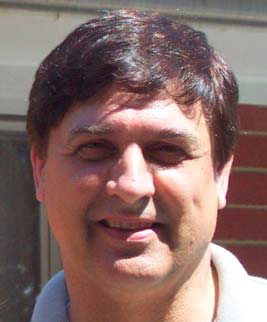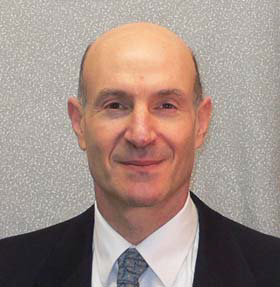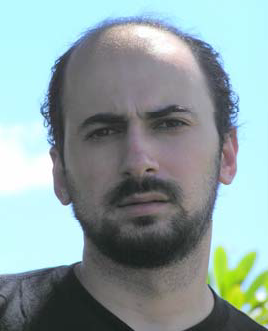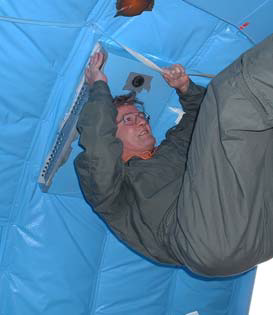 |   |
|
 HROVAT, Mirko I., Ph.D., is President and Chief Scientist at Mirtech, Inc., a company he established in 1995 to develop several ideas for NMR/MRI hardware as well as to collaborate and provide services to other MRI investigators. Dr. Hrovat received in PhD in Physical Chemistry from the University of Texas at Austin in 1982. He has 29 years of experience in many facets of MRI and has played an important role in the development of hyperpolarized xenon applications at Brigham and Women’s Hospital. He has extensive experience and expertise is in the areas of RF coil design, MRI system design, RF electronics, and pulse sequence development. In earlier work with Dr. Patz, he was responsible for modifications to a 0.2T commercial system to make it broadband. He has literally built hundreds of specialty rf coils for MRI for Dr. Patz and other investigators. Through his company Mirtech, Dr. Hrovat plays a key role in both the VS and MR-LDM research. Dr. Hrovat leads the effort to develop the magnets for both the VS and MR-LDM. He played a major role in Dr. Patz’s NIH Bioengineering Research Partnership research from 2003-2008 contributing to the development of pulse sequences, reconstruction algorithms, and data analysis procedures. Dr. Hrovat also developed custom hardware and software to perform system noise figure analysis. This apparatus proved invaluable in maximizing the signal to noise ratio. Regarding intellectual property, Dr. Patz and Dr. Hrovat are co-inventors of the VS. Dr. Patz, Dr. Hrovat, and Dr. Butler are co-inventors of the MR-LDM. HROVAT, Mirko I., Ph.D., is President and Chief Scientist at Mirtech, Inc., a company he established in 1995 to develop several ideas for NMR/MRI hardware as well as to collaborate and provide services to other MRI investigators. Dr. Hrovat received in PhD in Physical Chemistry from the University of Texas at Austin in 1982. He has 29 years of experience in many facets of MRI and has played an important role in the development of hyperpolarized xenon applications at Brigham and Women’s Hospital. He has extensive experience and expertise is in the areas of RF coil design, MRI system design, RF electronics, and pulse sequence development. In earlier work with Dr. Patz, he was responsible for modifications to a 0.2T commercial system to make it broadband. He has literally built hundreds of specialty rf coils for MRI for Dr. Patz and other investigators. Through his company Mirtech, Dr. Hrovat plays a key role in both the VS and MR-LDM research. Dr. Hrovat leads the effort to develop the magnets for both the VS and MR-LDM. He played a major role in Dr. Patz’s NIH Bioengineering Research Partnership research from 2003-2008 contributing to the development of pulse sequences, reconstruction algorithms, and data analysis procedures. Dr. Hrovat also developed custom hardware and software to perform system noise figure analysis. This apparatus proved invaluable in maximizing the signal to noise ratio. Regarding intellectual property, Dr. Patz and Dr. Hrovat are co-inventors of the VS. Dr. Patz, Dr. Hrovat, and Dr. Butler are co-inventors of the MR-LDM.
|
|
 PATZ, Samuel, Ph.D., is an Associate Professor of Radiology, Harvard Medical School, and the Scientific Director of the Center for Pulmonary Functional Imaging (CPFI) established by the Department of Radiology at Brigham & Women’s Hospital (BWH) in 2007. Dr. Patz received his PhD in Physics from Brandeis University in 1979. For the past 13 years, he has directed the CPFI group on pulmonary applications of hyperpolarized 129Xe. He is currently Principal Investigator (PI) on three grants, all focused on measuring pulmonary function with MRI. From 2003 - 2008, he served as the PI of a NIH Bioengineering Research Partnership (BRP) grant to develop infrastructure and applications for hyperpolarized 129Xe. The collaboration between investigators in the BRP and their groups was extraordinarily productive allowing the demonstration of the first human MRI images of pulmonary diffusive gas transport. Prior to that, both Dr. Patz and Dr. Hrovat (see below) were key members of a group that built a low field (60 Gauss) MRI scanner demonstrating the feasibility of obtaining ventilation images with hyperpolarized gas at low field. He and Dr. Hrovat solved numerous problems including adapting a research spectrometer with a down/up converter to allow operation at ~70kHz for 129Xe and 210kHz for 3He. Dr. Patz has extensive experience in pulse sequence development, notably making many contributions to Steady State Free Precession (SSFP) in the 1980’s. Dr. Patz also worked for several years with Dr. Pulyer in the initial stages of the conceptual development of the planar magnet, the basis for the magnet designs proposed here. Dr. Patz is intimately familiar with all the regulatory aspects of the group’s research as has written all of the IRB protocols for our research at BWH. Regarding intellectual property, Dr. Patz and Dr. Hrovat are co-inventors of the VS. Dr. Patz, Dr. Hrovat, and Dr. Butler are co-inventors of the MR-LDM. PATZ, Samuel, Ph.D., is an Associate Professor of Radiology, Harvard Medical School, and the Scientific Director of the Center for Pulmonary Functional Imaging (CPFI) established by the Department of Radiology at Brigham & Women’s Hospital (BWH) in 2007. Dr. Patz received his PhD in Physics from Brandeis University in 1979. For the past 13 years, he has directed the CPFI group on pulmonary applications of hyperpolarized 129Xe. He is currently Principal Investigator (PI) on three grants, all focused on measuring pulmonary function with MRI. From 2003 - 2008, he served as the PI of a NIH Bioengineering Research Partnership (BRP) grant to develop infrastructure and applications for hyperpolarized 129Xe. The collaboration between investigators in the BRP and their groups was extraordinarily productive allowing the demonstration of the first human MRI images of pulmonary diffusive gas transport. Prior to that, both Dr. Patz and Dr. Hrovat (see below) were key members of a group that built a low field (60 Gauss) MRI scanner demonstrating the feasibility of obtaining ventilation images with hyperpolarized gas at low field. He and Dr. Hrovat solved numerous problems including adapting a research spectrometer with a down/up converter to allow operation at ~70kHz for 129Xe and 210kHz for 3He. Dr. Patz has extensive experience in pulse sequence development, notably making many contributions to Steady State Free Precession (SSFP) in the 1980’s. Dr. Patz also worked for several years with Dr. Pulyer in the initial stages of the conceptual development of the planar magnet, the basis for the magnet designs proposed here. Dr. Patz is intimately familiar with all the regulatory aspects of the group’s research as has written all of the IRB protocols for our research at BWH. Regarding intellectual property, Dr. Patz and Dr. Hrovat are co-inventors of the VS. Dr. Patz, Dr. Hrovat, and Dr. Butler are co-inventors of the MR-LDM.
|
|
 DABAGHYAN, Mikayel, Ph.D., is a Postdoctoral Research Fellow in the BWH Center for Pulmonary Functional Imaging. Dr. Dabaghyan received his PhD from the Physics Department at the University of New Hampshire (UNH) in 2007 where he did basic research in nuclear physics. He joined the BWH Center for Pulmonary Functional Imaging in 2007 and has been working on a variety of topics, most recently the magnet design for both the VS and MR-LDM. Dr. Dabaghyan is an extremely well qualified experimental physicist with superb computer programming skills and a solid background in electromagnetics. He has programmed many of the pulse sequences we use for hyperpolarized studies on the clinical scanners we use. He has developed a Matlab based magnetic field simulation program that has allowed us to very quickly evaluate different magnet designs for both the VS and MR-LDM. The software includes extensive tools and is operated from multiple graphical user interfaces (GUIs). DABAGHYAN, Mikayel, Ph.D., is a Postdoctoral Research Fellow in the BWH Center for Pulmonary Functional Imaging. Dr. Dabaghyan received his PhD from the Physics Department at the University of New Hampshire (UNH) in 2007 where he did basic research in nuclear physics. He joined the BWH Center for Pulmonary Functional Imaging in 2007 and has been working on a variety of topics, most recently the magnet design for both the VS and MR-LDM. Dr. Dabaghyan is an extremely well qualified experimental physicist with superb computer programming skills and a solid background in electromagnetics. He has programmed many of the pulse sequences we use for hyperpolarized studies on the clinical scanners we use. He has developed a Matlab based magnetic field simulation program that has allowed us to very quickly evaluate different magnet designs for both the VS and MR-LDM. The software includes extensive tools and is operated from multiple graphical user interfaces (GUIs).
|
|
 BUTLER, James P., Ph.D., is an Associate Professor of Physiology at both the Harvard School of Public Health and Brigham & Women’s Hospital. He is an internationally known scholar and researcher in pulmonary mechanics as well as gas and aerosol transport in the lung. He is also a founding and key member of our Center for Pulmonary Functional Imaging (CPFI). He has a long history in pulmonary research, specifically tailored to bridging the disciplines of physics and physiology. In this regard, he has made many insightful and important contributions to our work by helping to interpret our experimental results in light of his considerable expertise in pulmonary physiology. His erudite analysis has helped us arrive at realistic interpretations and models of the data. He is also a superb mathematician and often contributes analytical models of our measurements that capture the essential physics and physiology. At the level of physiology, he has worked in a wide variety of cross-disciplinary fields: Cell mechanics, where he solved an inverse problem in computing tractions that cells exert on their substrate, and its extension to cell-cell interactions and mechanosensing; Fluid mechanics, where with colleagues, he probed lubrication of mesothelial surfaces in the pleural space; Aerosol transport mechanisms, where with colleagues he discovered chaotic mixing mechanisms that explain previously unknown transport and deposition of nanoparticles. He enjoys long standing collaborations with many experts spanning virtually all aspects of breathing. Dr. Butler received his PhD in physics from Harvard University in 1974 and he is a co-inventor of the MR-LDM. Note: Dr. Butler’s picture is aboard a KC-138 aircraft during zero gravity. BUTLER, James P., Ph.D., is an Associate Professor of Physiology at both the Harvard School of Public Health and Brigham & Women’s Hospital. He is an internationally known scholar and researcher in pulmonary mechanics as well as gas and aerosol transport in the lung. He is also a founding and key member of our Center for Pulmonary Functional Imaging (CPFI). He has a long history in pulmonary research, specifically tailored to bridging the disciplines of physics and physiology. In this regard, he has made many insightful and important contributions to our work by helping to interpret our experimental results in light of his considerable expertise in pulmonary physiology. His erudite analysis has helped us arrive at realistic interpretations and models of the data. He is also a superb mathematician and often contributes analytical models of our measurements that capture the essential physics and physiology. At the level of physiology, he has worked in a wide variety of cross-disciplinary fields: Cell mechanics, where he solved an inverse problem in computing tractions that cells exert on their substrate, and its extension to cell-cell interactions and mechanosensing; Fluid mechanics, where with colleagues, he probed lubrication of mesothelial surfaces in the pleural space; Aerosol transport mechanisms, where with colleagues he discovered chaotic mixing mechanisms that explain previously unknown transport and deposition of nanoparticles. He enjoys long standing collaborations with many experts spanning virtually all aspects of breathing. Dr. Butler received his PhD in physics from Harvard University in 1974 and he is a co-inventor of the MR-LDM. Note: Dr. Butler’s picture is aboard a KC-138 aircraft during zero gravity.
|
|
 WASHKO, George R., M.D., is an Assistant Professor of Medicine, Harvard Medical School, and Associate Physician in Pulmonary and Critical Care Medicine, Brigham and Women's Hospital. Dr. Washko is a key member of the Center for Pulmonary Functional Imaging. His overall research goal is to develop the tools necessary to use pulmonary imaging as a tool for the selection of more homogeneous subsets of subjects with COPD for therapeutic intervention and as an intermediate study endpoint for clinical investigation. There is a tremendous amount of heterogeneity in the clinical manifestations of smoking related lung disease including subject symptoms, susceptibility to the noxious effects of tobacco smoke, and the parenchymal and airway remodeling associated with chronic injury. This has made clinical investigation of COPD a challenge where even the most promising trials have found beneficial impact in only a subset of the study cohort. He believes that quantitative and qualitative image analysis can improve our understanding of disease pathophysiology, reduce some of the heterogeneity observed in COPD, and potentially allow the selection of subjects who are most and least likely to benefit from intervention. His background includes didactic training in both engineering at the University of Pennsylvania and clinical research over a decade later at Harvard Medical School. In that interval he completed Pulmonary and Critical Care Fellowship training where he was mentored in clinical research. He has since become the regional PI of the COPD Clinical Research Network as well as secured additional funding through the K23 mechanism and the Parker B. Francis Foundation, the later two of which are focused on the development and validation of image based biomarkers of lung disease. These experiences have allowed him to develop numerous national and international collaborations. Dr. Washko received his MD from Georgetown University School of Medicine in 1999. He is responsible for suggesting that the MR-LDM could be used to detect Exercise Induced Pulmonary Edema in race horses. WASHKO, George R., M.D., is an Assistant Professor of Medicine, Harvard Medical School, and Associate Physician in Pulmonary and Critical Care Medicine, Brigham and Women's Hospital. Dr. Washko is a key member of the Center for Pulmonary Functional Imaging. His overall research goal is to develop the tools necessary to use pulmonary imaging as a tool for the selection of more homogeneous subsets of subjects with COPD for therapeutic intervention and as an intermediate study endpoint for clinical investigation. There is a tremendous amount of heterogeneity in the clinical manifestations of smoking related lung disease including subject symptoms, susceptibility to the noxious effects of tobacco smoke, and the parenchymal and airway remodeling associated with chronic injury. This has made clinical investigation of COPD a challenge where even the most promising trials have found beneficial impact in only a subset of the study cohort. He believes that quantitative and qualitative image analysis can improve our understanding of disease pathophysiology, reduce some of the heterogeneity observed in COPD, and potentially allow the selection of subjects who are most and least likely to benefit from intervention. His background includes didactic training in both engineering at the University of Pennsylvania and clinical research over a decade later at Harvard Medical School. In that interval he completed Pulmonary and Critical Care Fellowship training where he was mentored in clinical research. He has since become the regional PI of the COPD Clinical Research Network as well as secured additional funding through the K23 mechanism and the Parker B. Francis Foundation, the later two of which are focused on the development and validation of image based biomarkers of lung disease. These experiences have allowed him to develop numerous national and international collaborations. Dr. Washko received his MD from Georgetown University School of Medicine in 1999. He is responsible for suggesting that the MR-LDM could be used to detect Exercise Induced Pulmonary Edema in race horses.
|
|
|
|
|